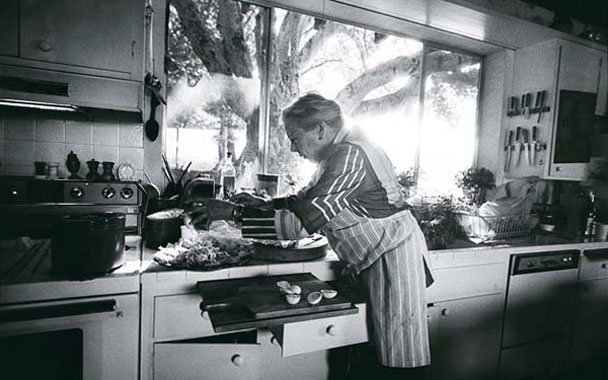It really didn’t look like much. The untitled book had a well-worn black cover and some clippings sticking out here and there. Inside, in scrabbly handwriting, I found the words Table Book, and as I slowly turned the pages, I began to realize the importance of this collection: Arranged by date, they were M. F. K. Fisher’s unexpurgated notes on those who’d come to visit, the food she’d served, the reactions of her guests, and her own reactions to them. The book had been at the bottom of a carton of gleanings from Fisher that had been sitting on my floor for weeks. One day (a few years before she died) she’d asked me to go through her library and take whatever I wanted, so I packed up a few boxes without looking too closely at things. Now, I’d finally cleared my own overburdened bookshelves to make room for Fisher’s trove. I looked again at the book in my hands. From her first published work, in 1937, to her last volume of memoirs, published posthumously in 1995, Mary Frances Kennedy Fisher insisted on good, honest food and good, honest writing. That said, she was also famously cryptic and charmingly enigmatic. This book might well have been her only confidant. I sat down immediately and began to read.
“PC a food addict,” Fisher noted in June 1965. He “stopped before dessert—claimed it was the first thing he had eaten for 2 weeks, except bread & water. He is very imitative—limited intelligence but brash.” Another guest “arrives stoned from party—late—no apologies.” Another had the “taste buds of an ostrich.” She was particularly adroit at the art of damning with faint praise. Of lunch with food writer James Villas, she notes, he “ate nothing—hungover? OK interview? Pleasant non-encounter—near miss.” But she also needed only a few words—“Provençal, lush, beautiful”—for a much enjoyed afternoon with Alice Waters and friends. For measuring success, Fisher invoked the classic standard of her friend James Beard: “It was a nice party. Nobody cried. Nobody threw up.”
Nothing seemed to annoy Fisher like fussiness. “Miss E. cannot eat a dozen things … because of a recurrent pain in the gall bladder, or she cannot chew them w/ her double clickers or she is prejudiced against them for unknown but probably racial reasons.” And, if fussiness was reprehensible, nonfussiness was even more irksome: “They will eat anything that is set before them,” she writes of two dinner guests. “They chomp right through, making appreciative noises on schedule.”
But whatever her criticisms of others, sometimes she turned her unflinching eye upon herself—and for good reason, since one year she almost poisoned her entire family at Christmas. “You are now entering tomane [sic] junction,” she wrote of the near-disastrous meal. “In my unreasonable desire to have everything culinary well under control, so that we could all sit around and talk and enjoy the baby and so on … I had blandly advised Bill to stuff the turkey at night, and roast it the next morning. I knew better. I was not thinking. This was dangerous enough, with quantities of raw oysters chopped in the warm dressing and packed into the very perishable carcass, and to compound my idiocy the weather turned very balmy during the night the bird sat on the back porch. A perfect prescription for … mass murder… ” She even imagined a headline: “Noted Gourmet Does In Family.”
Occasionally, Fisher included specifics about how she prepared a dish, as well as any shortcuts she had taken. She seemed to enjoy the fact that no one would ever think her capable of resorting to such “tricks,” because she was, after all, M. F. K. Fisher. “I followed the Rombauer recipe pretty well. Then I added two cans of Campbell’s Cream of Potato, which has the potatoes in little cubes … and as I added the pre-cooked asparagus tips I added about a half-cup of chopped parsely [sic] … all to add to the too-delicate flavor and make it look greener. Excellent! A lowdown trick, but worth it.”
Poring over every menu and marginal note in the book, I eventually worked my way through to October 3, 1977, the date of my very first visit with Fisher. Through squinted, reluctant eyes, I read the menu: “Wafers, chermoula, rolls, salad, lettuce, h.b. eggs, prawns, ww [white wine], coffee, shortbread.” So far, so good. “Very pleasant long lunch, interesting people.” Well, not overly enthusiastic, perhaps, but not too awful. On the other hand, I wonder what she meant by “long”?

